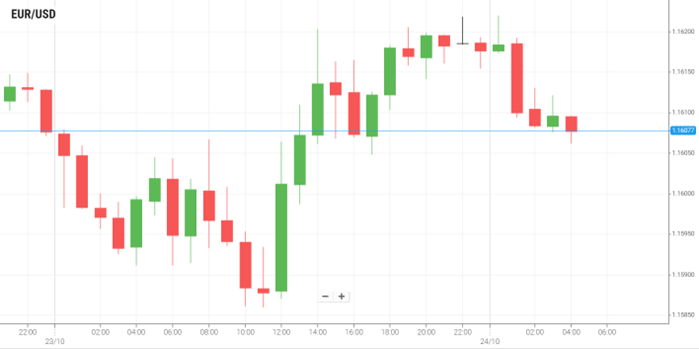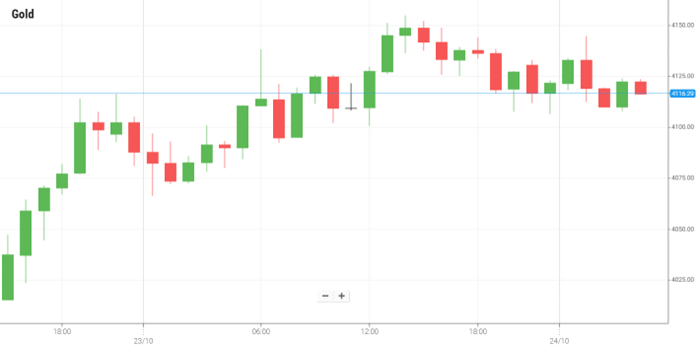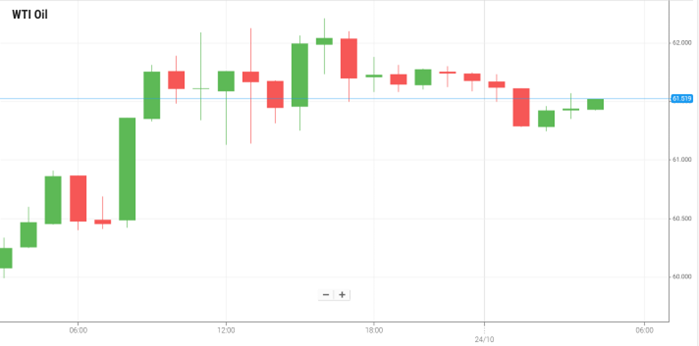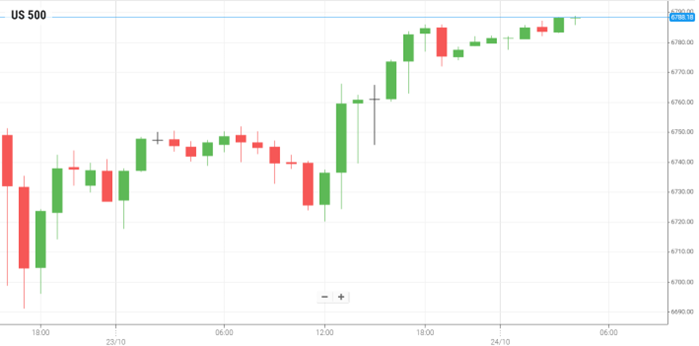This website uses cookies and is meant for marketing purposes only.
The USDX is posting modest losses, softening to around 98.90 during Friday's early Asian session. The dollar's weakness is driven by ongoing concerns about the prolonged US government shutdown, which has now entered its 24th day, marking the second-longest lapse in history with no resolution in sight. This political gridlock continues to erode confidence in US economic governance. The shutdown is also complicating the Federal Reserve's ability to help the economy by delaying key data releases, though the Fed is prepared to consider alternative sources. Market expectations remain heavily focused on easing, with a Reuters poll suggesting the Fed is likely to deliver a 25 basis point rate cut next week and again in December.
Gold is declining below the $4,100 mark during Friday's early European session, extending a downtrend that saw the precious metal lose 0.69% on Thursday. The current move is pressured by a rebound in the US Dollar and the belief that the end of the Diwali festival in India could be reducing physical demand. Traders are also engaged in profit-taking ahead of the crucial US September CPI inflation data due later today. Weighing on sentiment is the renewed US-China trade friction, as the Trump administration is reportedly considering restricting a broad range of software-driven exports to China as retaliation. Despite the selling pressure, the downside for the safe-haven asset remains limited by persistent global trade tensions. High-level trade negotiations between the US and China are scheduled to begin in Malaysia later today, involving Vice-Premier He Lifeng, US Treasury Secretary Scott Bessent, and Trade Representative Jamieson Greer.
Asian equity markets rose broadly on Friday, primarily led by gains in technology shares. The positive sentiment was significantly boosted by confirmation from the White House that US President Donald Trump will meet Chinese counterpart Xi Jinping next week. This development helped ease concerns over recent trade frictions and renewed hopes for de-escalation.
Chinese equities gained ground after the Communist Party unveiled a new five-year economic plan emphasizing technological self-reliance, advanced manufacturing, and stronger domestic demand. This reinforced optimism about Beijing's commitment to structural reform and growth. As of 06:43 AM GMT, the China SSE rose 0.66%, the China SZSE jumped 1.90%, and the Hong Kong 50 advanced 0.29%.
Japanese shares were higher, with the Japan 225 up 0.33% as of 06:43 AM GMT. Investors digested mixed economic data: while core consumer prices remained above the central bank's $2\%$ target, Japan's factory activity slipped to its weakest level in 19 months. The market remains focused on the new Prime Minister Sanae Takaichi, whose government is reportedly preparing a large stimulus package aimed at curbing inflation and boosting high-tech investment.
The main US equity indices tracked a higher close on Wall Street overnight, bolstering risk appetite. This was supported by upbeat corporate earnings, notably from tech giant Intel, whose shares surged 3.30% on Thursday. US stock futures ticked higher in Asian trading. In other corporate news, Tesla shares moved 2.35% higher during Thursday's afternoon U.S. trading, recovering from an initial sharp decline. The electric vehicle maker reported record quarterly revenue of $28.1 billion, beating Wall Street estimates. However, the company's adjusted earnings of $0.50 per share fell short of expectations ($0.54). The market largely overlooked the earnings miss, focusing instead on the strong revenue and delivery numbers, even as the company braces for a potential slowdown in U.S. demand.
The central focus for traders later today is the release of the US September Consumer Price Index (CPI) inflation data. Economists forecast a $0.4%$ monthly increase in headline CPI, equating to a $3.1%$ annual rate. A hotter-than-expected inflation outcome, however, could provide a near-term lift to the dollar. Furthermore, investors cautiously await the Federal Reserve’s policy meeting next week, where a rate cut is widely expected.
The EUR/USD pair ended the session with minor gains on Thursday, as markets awaited the release of September’s U.S. inflation figures.
Market activity remained subdued amid a light economic calendar and cautious sentiment ahead of Friday’s Consumer Price Index (CPI) report. In the United States, Existing Home Sales for September exceeded expectations on a month-over-month basis, providing a minor boost to the greenback.
Meanwhile, the White House confirmed that President Donald Trump will meet Chinese President Xi Jinping on Thursday in South Korea. Before that, he is set to meet Japan’s new Prime Minister, Takaichi, on Tuesday, followed by talks with South Korea’s President on Wednesday.
Despite the headline news, EUR/USD showed limited reaction, as investors focused on U.S. trade rhetoric toward China and the ongoing government shutdown, now in its twenty-third day. The upcoming CPI data is expected to show both headline and core inflation rising above 3%, a figure that could influence the Federal Reserve’s next policy move.
In Europe, Consumer Confidence for October improved slightly to -14.2, up from -14.9 previously, reflecting modest optimism despite persistent economic challenges.
Comments from European Central Bank officials highlighted diverging views on policy direction. ECB’s Kazaks suggested that the next move “could as easily be a hike as a cut,” while Villeroy maintained that a cut remains more likely. Kocher noted an equal probability of either outcome, reflecting uncertainty within the Governing Council.

Gold prices climbed nearly 1% on Thursday, snapping a two-session losing streak as renewed geopolitical risks boosted demand for safe-haven assets and investors awaited key U.S. inflation data due Friday.
Investor caution deepened after U.S. President Donald Trump imposed Ukraine-related sanctions on Russian energy firms Lukoil and Rosneft, marking the first such measures of his second term. The administration is also reportedly weighing restrictions on software-driven exports to China, in response to Beijing’s recent limits on rare-earth exports.
Markets now turn to Friday’s U.S. Consumer Price Index (CPI) report, seen as a key gauge for the Federal Reserve’s policy outlook ahead of next week’s meeting. Economists expect core inflation to remain steady at 3.1% in September.
Investors have largely priced in a 25-basis-point rate cut, with an additional reduction expected by December. Lower interest rates typically benefit gold, a non-yielding asset, by reducing the opportunity cost of holding it.

Oil prices jumped on Thursday, reaching their highest levels in two weeks after the United States imposed sanctions on Russian energy majors Rosneft and Lukoil over Moscow’s ongoing war in Ukraine. The move prompted refiners in China and India—two of Russia’s largest buyers—to consider cutting their imports of Russian crude.
The announcement of sanctions by the U.S. on Rosneft and Lukoil is a major escalation in targeting Russia’s energy sector and could be a big enough shock to flip the global oil market into deficit next year.
Moreover, the new sanctions could force Chinese and Indian refineries to seek alternative suppliers to avoid being cut off from the Western banking system.
Kuwait’s oil minister said the Organization of the Petroleum Exporting Countries (OPEC) stands ready to offset any supply disruptions by adjusting output cuts if needed. However, Russian President Vladimir Putin downplayed the move’s impact, saying it would take time for global markets to replace Russian supply.
The U.S. government reiterated that it is prepared to take additional action and called on Moscow to agree immediately to a ceasefire in Ukraine.

The US 500 closed higher on Thursday, led by technology shares, as easing U.S.-China trade tensions lifted market sentiment. Gains came after the White House confirmed a meeting between President Donald Trump and Chinese President Xi Jinping later this month.
Market optimism improved after White House Press Secretary Karoline Leavitt confirmed that Trump and Xi will meet on October 30, easing fears of a renewed trade war between the world’s two largest economies.
Tesla shares slipped after the company reported mixed quarterly results. While revenue hit a record $28.1 billion, narrowly beating expectations, net income dropped 37% amid rising research, development, and tariff-related costs, and as the EV maker braces for weaker U.S. demand following the expiration of federal tax credits.
IBM shares also fell, as software revenue growth missed estimates, even though the company posted better-than-expected third-quarter earnings and raised its full-year guidance, citing continued AI-driven momentum.
Investors awaited Intel’s quarterly results, scheduled after the closing bell. The chipmaker was expected to report flat earnings for the third quarter, with sales down 1.2% to $13.12 billion, weighed by weakness in its data center and AI segments. I
Broader Market Highlights
American Airlines rose after reporting better-than-expected quarterly results, with smaller-than-anticipated losses.
In a separate development, President Trump announced sanctions on Russia’s largest oil producers, Lukoil and Rosneft, citing Moscow’s “lack of serious commitment to a peace process” in Ukraine.

The materials contained on this document should not in any way be construed, either explicitly or implicitly, directly or indirectly, as investment advice, recommendation or suggestion of an investment strategy with respect to a financial instrument, in any manner whatsoever. Any indication of past performance or simulated past performance included in this document is not a reliable indicator of future results. For the full disclaimer click here.
Join iFOREX to get an education package and start taking advantage of market opportunities.